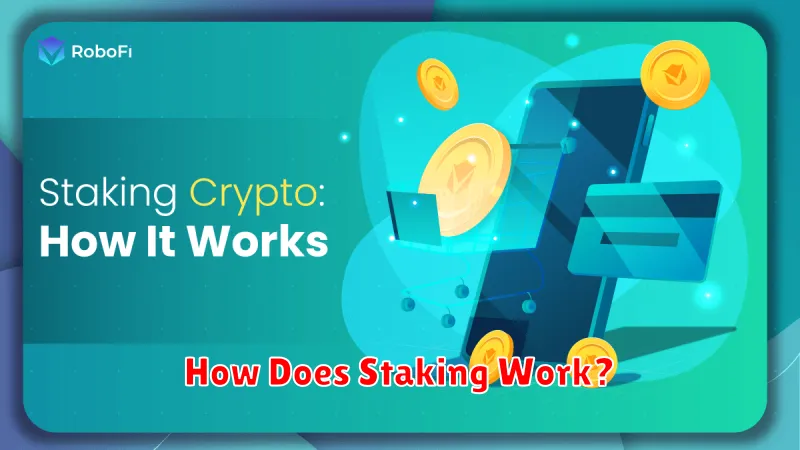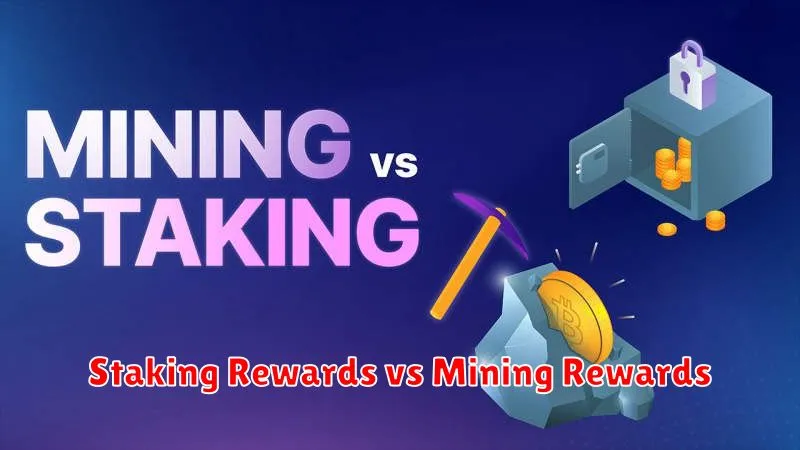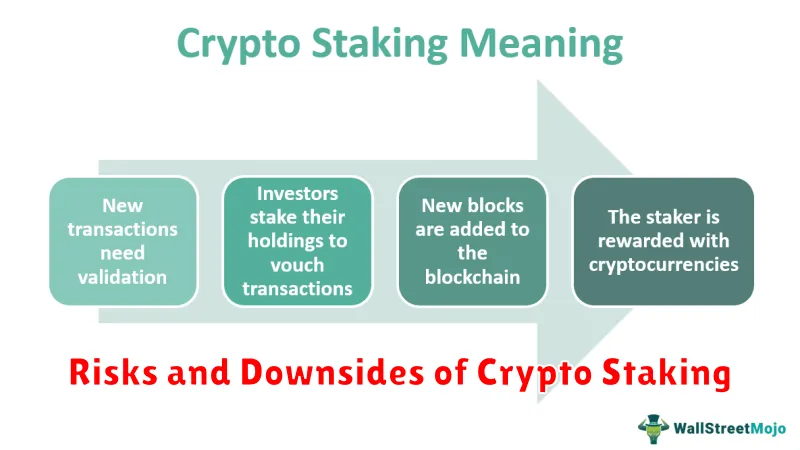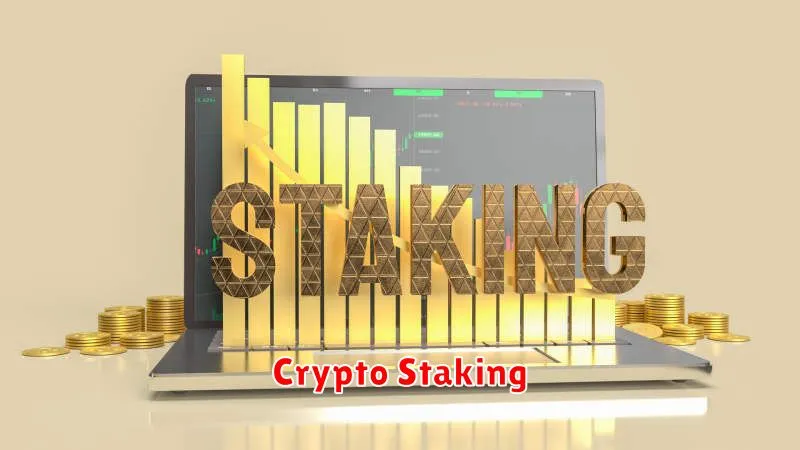Learn the basics of crypto staking and unlock the potential of passive income. This guide provides a clear and concise explanation of how crypto staking works, detailing the process, risks, and rewards. Discover how you can earn passive income by securing the blockchain networks of various cryptocurrencies and understand the crucial aspects before you begin your crypto staking journey.
What is Crypto Staking?

Crypto staking is a process that allows you to earn passive income by locking up your cryptocurrency holdings on a blockchain network that uses a proof-of-stake (PoS) consensus mechanism. Instead of mining (which requires significant energy and computing power), you “stake” your coins to validate transactions and secure the network.
In essence, you’re committing your crypto assets to support the network’s operations. In return, you receive rewards in the form of newly minted coins or transaction fees. The amount you earn depends on factors such as the amount staked, the network’s inflation rate, and the validator’s performance.
Staking is a relatively straightforward way to earn passive income from your crypto holdings, although it does require you to understand the risks involved and choose a reputable staking provider.
How Does Staking Work?

Staking is a process where you lock up your cryptocurrency holdings to support the security and operations of a blockchain network. In return, you earn rewards in the form of more cryptocurrency.
It’s similar to earning interest in a savings account, but instead of a bank, you’re contributing to a decentralized network. The specific mechanics vary depending on the blockchain, but generally involve validating transactions or creating new blocks of transactions.
To stake, you typically need to hold a minimum amount of the cryptocurrency and use a staking wallet or exchange that supports staking. The amount of rewards you earn depends on factors like the amount staked, the network’s inflation rate, and the number of other stakers.
The process often involves locking up your coins for a specific period, sometimes with an unstaking period before you can access your funds. Therefore, it’s crucial to understand the terms and conditions before staking your cryptocurrency.
Best Cryptocurrencies for Staking

Choosing the best cryptocurrency for staking depends on several factors, including your risk tolerance, technical expertise, and desired return. However, some consistently popular options include Ethereum (ETH), known for its large and established ecosystem, and Cardano (ADA), appreciated for its robust and energy-efficient proof-of-stake mechanism.
Cosmos (ATOM) offers a unique interoperability focus, allowing staking across different blockchains. Solana (SOL) provides high transaction speeds, but its network’s stability has been questioned at times. Polkadot (DOT) participates in a parachain network, potentially offering diversified staking opportunities. Finally, Tezos (XTZ) is known for its energy-efficient and self-amending blockchain.
It’s crucial to thoroughly research each cryptocurrency before staking. Consider factors like the annual percentage yield (APY), the lock-up period (if any), the security of the staking platform, and the overall health and stability of the network. Remember that cryptocurrency investments are inherently risky, and returns are not guaranteed.
Staking Rewards vs Mining Rewards

Both staking and mining offer ways to earn passive income in the cryptocurrency world, but they differ significantly in their mechanisms and requirements. Mining involves solving complex computational problems to validate transactions and add new blocks to a blockchain, requiring significant energy consumption and specialized hardware. Rewards are typically paid in the cryptocurrency being mined.
In contrast, staking requires users to lock up their cryptocurrency in a wallet or on an exchange to help validate transactions and secure the network. This process is generally far less energy-intensive than mining and often requires only a modest technical understanding. Rewards are usually paid in the cryptocurrency being staked, but may also include other cryptocurrencies or tokens.
The key differences lie in the technical demands, energy consumption, and reward mechanisms. Mining is computationally intensive and energy-hungry, yielding rewards in the mined cryptocurrency. Staking is comparatively less demanding, offering rewards in the staked cryptocurrency or other tokens, potentially providing a more accessible and environmentally friendly passive income stream.
Top Staking Platforms in 2025

Predicting the top staking platforms in 2025 is challenging due to the dynamic nature of the cryptocurrency market. However, several platforms are currently well-positioned for continued success based on factors like security, user experience, and range of supported cryptocurrencies.
Binance, a leading cryptocurrency exchange, is likely to remain a prominent player, offering a wide array of staking options and high liquidity. Kraken, known for its robust security and institutional-grade features, is another strong contender. Coinbase, focusing on user-friendliness and regulatory compliance, will likely continue to attract a large user base.
Beyond these established players, newer platforms with innovative approaches to staking, such as those leveraging decentralized finance (DeFi) protocols or offering unique staking rewards, could emerge as significant competitors. The specific ranking of these platforms will depend on technological advancements, regulatory changes, and overall market trends.
It is crucial to conduct thorough due diligence before choosing a staking platform. Consider factors such as the platform’s reputation, security measures, fees, and the supported cryptocurrencies before committing funds.
Risks and Downsides of Crypto Staking

While crypto staking offers the potential for passive income, it’s crucial to understand the inherent risks. Impermanent loss can occur in liquidity pool staking when the relative value of assets changes, resulting in a lower overall value compared to holding them individually.
Smart contract risks are a significant concern. Bugs or vulnerabilities in the staking contract’s code could lead to the loss of your staked assets. Thorough research of the contract’s security and audits is essential.
Exchange risks are relevant if you stake through a centralized exchange. The exchange’s solvency and security are crucial, as their failure could compromise your staked assets. Consider the exchange’s track record and reputation carefully.
Regulatory uncertainty is a growing concern. Changes in regulations could impact the legality and taxation of staking rewards, creating unforeseen financial implications.
Inflationary pressures can impact the value of your staked cryptocurrency over time, potentially negating the rewards earned. It’s important to consider the tokenomics of the specific cryptocurrency you are staking.
Finally, opportunity cost should be considered. The capital locked up in staking could be used for other potentially profitable ventures. Weigh the potential returns of staking against other investment opportunities.

